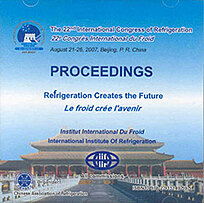
IIR document
Thermal conductivity of controlled ice-fraction materials.
Author(s) : CARSON J. K., WANG J. F., WILLIX J., et al.
Summary
Effective thermal conductivity predictions for frozen products require both an ice fraction model and an effective thermal conductivity model; hence there are two degrees of freedom when comparing model predictions to experimental data for real foods, which can lead to misleading conclusions. To avoid ice fraction prediction uncertainties, thermal conductivity was measured for two types of ice samples (ice chips produced by a commercial ice maker, and synthetic snow) in which the ice and air fractions were controlled. Levy's effective thermal conductivity model provided reasonable predictions for the ice-chip data, although greater accuracy was obtained using a composite effective medium theory and co-continuous model. The Maxwell-Eucken model provided reasonable predictions for the synthetic snow data; however, systematic error in these measurements may have been significant.
Available documents
Format PDF
Pages: ICR07-C2-536
Available
Public price
20 €
Member price*
Free
* Best rate depending on membership category (see the detailed benefits of individual and corporate memberships).
Details
- Original title: Thermal conductivity of controlled ice-fraction materials.
- Record ID : 2008-0270
- Languages: English
- Source: ICR 2007. Refrigeration Creates the Future. Proceedings of the 22nd IIR International Congress of Refrigeration.
- Publication date: 2007/08/21
Links
See other articles from the proceedings (839)
See the conference proceedings
Indexing
- Themes: Freezing of foodstuffs
- Keywords: Thermal conductivity; Food; Measurement; Frozen food; Small ice
-
Alternative models to predict the thermal condu...
- Author(s) : WANG J. F., CARSON J. K., NORTH M. F., et al.
- Date : 2006/02/16
- Languages : English
- Source: Innovative Equipment and Systems for Comfort and Food Preservation.
- Formats : PDF
View record
-
Modelling thermal conductivity of frozen foods ...
- Author(s) : TARNAWSKI V. R., BOVESECCHI G., COPPA P., et al.
- Date : 2007/08/21
- Languages : English
- Source: ICR 2007. Refrigeration Creates the Future. Proceedings of the 22nd IIR International Congress of Refrigeration.
- Formats : PDF
View record
-
Predicting the thermal conductivity of low wate...
- Author(s) : CARSON J. K., WANG J. F., NORTH M. F., et al.
- Date : 2011/08/21
- Languages : English
- Source: Proceedings of the 23rd IIR International Congress of Refrigeration: Prague, Czech Republic, August 21-26, 2011. Overarching theme: Refrigeration for Sustainable Development.
- Formats : PDF
View record
-
ESTIMATION OF THERMOPHYSICAL PROPERTIES OF FOOD...
- Author(s) : SUCCAR J.
- Date : 1985
- Languages : English
View record
-
THE RATES OF CHANGE OF ICE CRYSTAL SIZE IN FROZ...
- Author(s) : REID D. S.
- Date : 1987/08/24
- Languages : English
- Source: Development in refrigeration, refrigeration for development. Proceedings of the XVIIth international Congress of Refrigeration.
- Formats : PDF
View record
